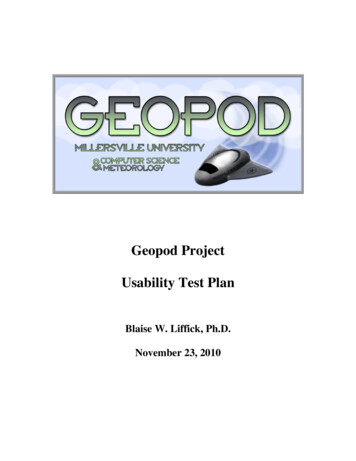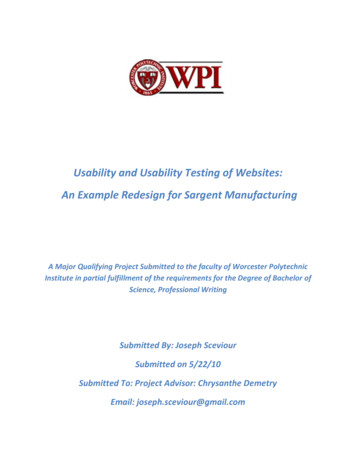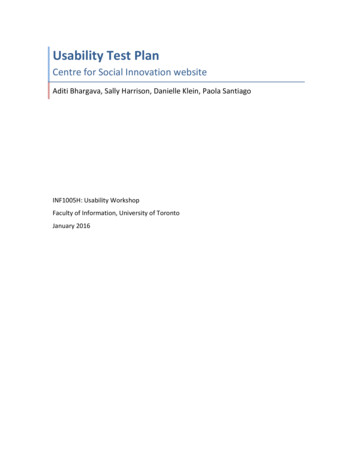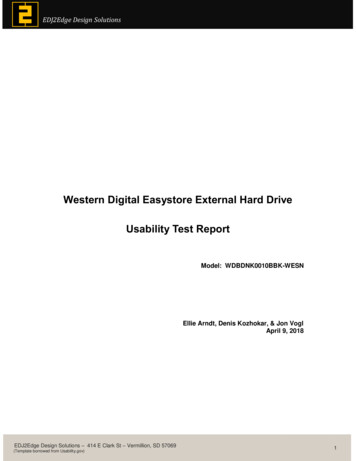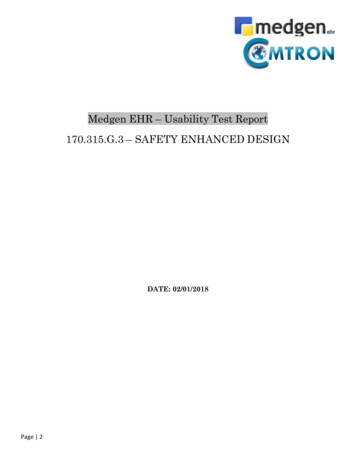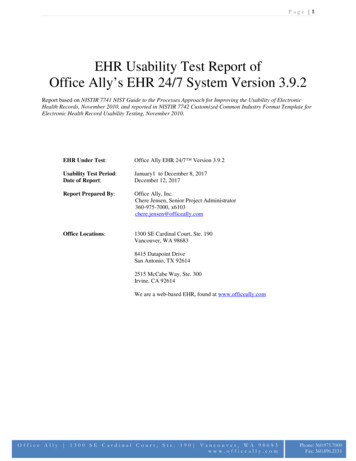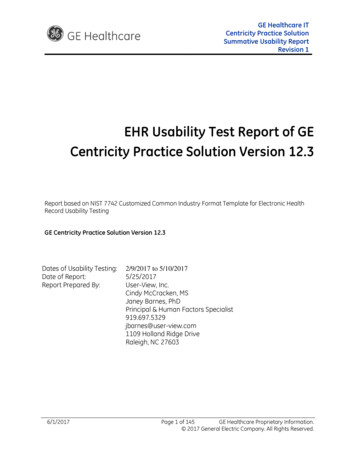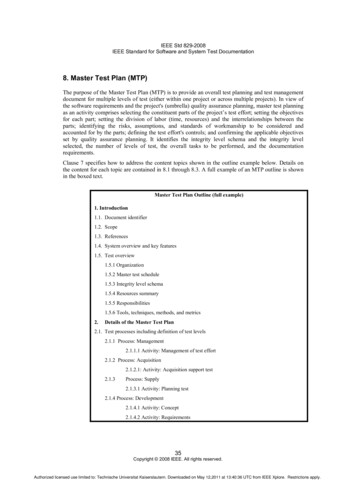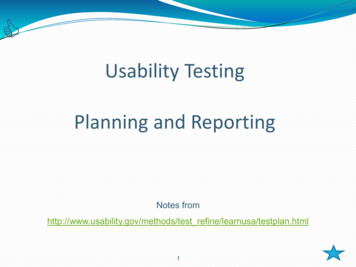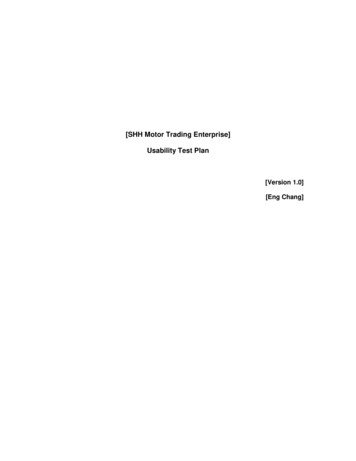
Transcription
[SHH Motor Trading Enterprise]Usability Test Plan[Version 1.0][Eng Chang]
Document OverviewThis document describes a test plan for conducting a usability test during the developmentof SSH Motor Trading Enterprise System. The goals of usability testing includeestablishing a baseline of user performance, establishing and validating user performancemeasures, and identifying potential design concerns to be addressed in order to improveease of use and end-user satisfaction.The usability test objectives are: To determine design inconsistencies and usability problem areas within theuser interface and content areas. Potential sources of error may include:o Navigation errors – failure to locate functions, excessive keystrokesto complete a function, failure to follow recommended screen flow.o Presentation errors – failure to locate and properly act upon desiredinformation in screens, selection errors due to labeling ambiguities.o Control usage problems – improper toolbar or entry field usage. Exercise the application under controlled test conditions with representativeusers. Data will be used to access whether usability goals regarding aneffective, efficient, and well-received user interface have been achieved. Establish baseline user performance and user-satisfaction levels of the userinterface for future usability evaluations.The user who will be testing the application will be the actual primary user of the completedsystem. We are hoping to have a minimum of 5 testers (As the eventual user base of the systemis small ( 20), we believe a 25% sample size will suffice in getting the analysis we need. Testingwill occur in client site with dummy data.2MethodologyA. Collecting qualitative metricsUsers of the test are categorized into various groups:1) Super Admin – User who has access to all privileges and access all aspects of thesystem (including analytics modules)2) Inventory User – User who has access to inventory management module3) Customer User – User who has access to customer management module4) Order User – User who has access to order management moduleUsers are encouraged to go with their instincts in accomplishing each task so as to better allowthe facilitators to record down accurate information of the testers’ thought processes. Facilitatorswill also be observing for errors (e.g. false/unintended clicks) and navigation issues. Uponcompletion of all the stipulated tasks (in accordance to each users’ predefined role), the tester willbe presented a questionnaire in which he/she will be asked what he dislikes / likes about theapplication and their satisfaction level of the application.2
The testing process will also be recorded via video using and will complement the facilitators’observations. Facilitators are to note and record body languages. All data necessary such as login details and other dummy data will be provided.B. Collecting quantitative metricsQuantitative metrics to be measured include: The amount of time to complete each task The number of clicks taken for completing each task (and of which how many arefalse clicks)2.1ParticipantsThe participants' responsibilities will be to attempt to complete a set of representative taskscenarios presented to them in as efficient and timely a manner as possible, and to providefeedback regarding the usability and acceptability of the user interface. The participantswill be directed to provide honest opinions regarding the usability of the application, and toparticipate in post-session subjective questionnaires and debriefing.The participants are expected to have basic computer skills and experience, example –knows how to use the keyboard and mouse & experienced in using browsers to completesimple tasks (e.g. register a user account and make online purchases)The participant will be staff from SSH Motor Trading. Our project sponsor, Mr. JonathanToh will help to facilitate the selection of testers.2.2TrainingParticipants will receive the overview of the usability test procedure, equipment andapplication. Facilitator will explain the objectives of the key functionalities of the system.2.3ProcedureParticipants will take part in the usability test at SSH Motor Trading’s office in BukitTimah. A machine (desktop/laptop) with the web application and database will be used in atypical office environment. The participant’s interaction with the Web application will bemonitored by the facilitator seated in the same office. Note takers and data logger(s) willmonitor the sessions in observation room, connected by video camera feed. The testsessions will be videotaped.The facilitator will brief the participants on the Web site/Web application and instruct theparticipant that they are evaluating the application, rather than the facilitator evaluating theparticipant. Participants will sign an informed consent that acknowledges: the participationis voluntary, that participation can cease at any time, and that the session will bevideotaped but their privacy of identification will be safeguarded. The facilitator will ask theparticipant if they have any questions.Participants will complete a pretest demographic and background informationquestionnaire. The facilitator will explain that the amount of time taken to complete the testtask will be measured and that exploratory behavior outside the task flow should not occur3
until after task completion. Time-on-task measurement begins when the participant startsthe task.The facilitator will observe and enter user behavior, user comments, and system actions inthe data logging application.After each task, the participant will complete the post-task questionnaire and elaborate onthe task session with the facilitator. After all task scenarios are attempted, the participantwill complete the post-test satisfaction questionnaire.3RolesThe roles involved in a usability test are as follows. An individual may play multiple rolesand tests may not require all roles.Facilitator Provides overview of study to participants Defines usability and purpose of usability testing to participants Assists in conduct of participant and observer debriefing sessions Responds to participant's requests for assistanceData Logger Records participant’s actions and commentsTest Observers Silent observer Assists the data logger in identifying problems, concerns, coding bugs, andprocedural errors Serve as note takers3.1EthicsAll persons involved with the usability test are required to adhere to the following ethicalguidelines: The performance of any test participant must not be individually attributable.Individual participant's name should not be used in reference outside the testingsession. A description of the participant's performance should not be reported to his or hermanager.4Usability Tasks[The usability tasks were derived from test scenarios developed from use cases and/or withthe assistance of a subject-matter expert. Due to the range and extent of functionalityprovided in the application or Web site, and the short time for which each participant will beavailable, the tasks are the most common and relatively complex of available functions.The tasks are identical for all participants of a given user role in the study.]The task descriptions below are required to be reviewed by the application owner,business-process owner, development owner, and/or deployment manager to ensure thatthe content, format, and presentation are representative of real use and substantially4
evaluate the total application. Their acceptance is to be documented prior to usabilitytestS/N1ModulesRole Management2System Template3Inventory Management4Order Management5Customer Management6Analytics – WarehouseOptimizationAnalytics – PricingAnalytics – CustomerBehavioral Analysis78Test Parameters1) Create Role2) Update Role3) Create User4) Add User1) Add car brand and model2) Create a full template with 5parts from different category3) Add car (from newly createdtemplate – latest)4) Add car part5) Update car6) Update car part7) Scrap car with parts kept8) Scrap car with parts disposed9) Check log transactions for allfunctions (e.g. create, delete,scraped)1) Save a quotation2) Complete an order (new taskand not a continuation from 1)3) Complete an order(continuation from 1)1) Add a new customer intodatabaseTesterSuper AdminManagerInventory UserOrder UserCustomer UserSuper AdminSuper AdminSuper Admin.5Usability MetricsUsability metrics refers to user performance measured against specific performance goalsnecessary to satisfy usability requirements. Scenario completion success rates, adherenceto dialog scripts, error rates, and subjective evaluations will be used. Time-to-completion ofscenarios will also be collected.5.1Scenario CompletionEach scenario will require, or request, that the participant obtains or inputs specific datathat would be used in course of a typical task. The scenario is completed when theparticipant indicates the scenario's goal has been obtained (whether successfully orunsuccessfully) or the participant requests and receives sufficient guidance as to warrantscoring the scenario as a critical error.5.2Critical ErrorsCritical errors are deviations at completion from the targets of the scenario. Obtaining orotherwise reporting of the wrong data value due to participant workflow is a critical error.Participants may or may not be aware that the task goal is incorrect or incomplete.5
Independent completion of the scenario is a universal goal; help obtained from the otherusability test roles is cause to score the scenario a critical error. Critical errors can also beassigned when the participant initiates (or attempts to initiate) and action that will result inthe goal state becoming unobtainable. In general, critical errors are unresolved errorsduring the process of completing the task or errors that produce an incorrect outcome.5.3Non-critical ErrorsNon-critical errors are errors that are recovered from by the participant or, if not detected,do not results in processing problems or unexpected results. Although non-critical errorscan be undetected by the participant, when they are detected they are generally frustratingto the participant.These errors may be procedural, in which the participant does not complete a scenario inthe most optimal means (e.g., excessive steps and keystrokes). These errors may also beerrors of confusion (ex., initially selecting the wrong function, using a user-interface controlincorrectly such as attempting to edit an un-editable field).Noncritical errors can always be recovered from during the process of completing thescenario. Exploratory behavior, such as opening the wrong menu while searching for afunction, will be recorded as a non-critical error.5.4Subjective EvaluationsSubjective evaluations regarding ease of use and satisfaction will be collected viaquestionnaires, and during debriefing at the conclusion of the session. The questionnaireswill utilize free-form responses and rating scales.5.5Scenario Completion Time (time on task)The time to complete each scenario, not including subjective evaluation durations, will berecorded.7Usability GoalsThe next section describes the usability goals for SSH Motor Trading Enterprise SystemRateCompletion rate is the percentage of test participants who successfully complete the taskwithout critical errors. A critical error is defined as an error that results in an incorrect orincomplete outcome. In other words, the completion rate represents the percentage ofparticipants who, when they are finished with the specified task, have an "output" that iscorrect. Note: If a participant requires assistance in order to achieve a correct output thenthe task will be scored as a critical error and the overall completion rate for the task will beaffected.A completion rate of 100% is the goal for each task in this usability test.7.1Error-free rateError-free rate is the percentage of test participants who complete the task without anyerrors (critical or non-critical errors). A non-critical error is an error that would not have animpact on the final output of the task but would result in the task being completed lessefficiently.An error-free rate of 80% is the goal for each task in this usability test.6
7.2Time on Task (TOT)The time to complete a scenario is referred to as "time on task". It is measured from thetime the person begins the scenario to the time he/she signals completion.7.3Subjective MeasuresSubjective opinions about specific tasks, time to perform each task, features, andfunctionality will be surveyed. At the end of the test, participants will rate their satisfactionwith the overall system. Combined with the interview/debriefing session, these data areused to assess attitudes of the participants.8Problem SeverityTo prioritize recommendations, a method of problem severity classification will be used inthe analysis of the data collected during evaluation activities. The approach treats problemseverity as a combination of two factors - the impact of the problem and the frequency ofusers experiencing the problem during the evaluation.8.1ImpactImpact is the ranking of the consequences of the problem by defining the level of impactthat the problem has on successful task completion. There are three levels of impact: High - prevents the user from completing the task (critical error) Moderate - causes user difficulty but the task can be completed (non-criticalerror) Low - minor problems that do not significantly affect the task completion (noncritical error)8.2FrequencyFrequency is the percentage of participants who experience the problem when working ona task. 8.3High: 30% or more of the participants experience the problemModerate: 11% - 29% of participants experience the problemLow: 10% or fewer of the participants experience the problemProblem Severity ClassificationThe identified severity for each problem implies a general reward for resolving it, and ageneral risk for not addressing it, in the current re
Usability Test Plan [Version 1.0] [Eng Chang] 2 Document Overview This document describes a test plan for conducting a usability test during the development of SSH Motor Trading Enterprise System. The goals of usability testing include establishing a baseline of user performance, establishing and validating user performance measures, and identifying potential design concerns to be addressed in .

